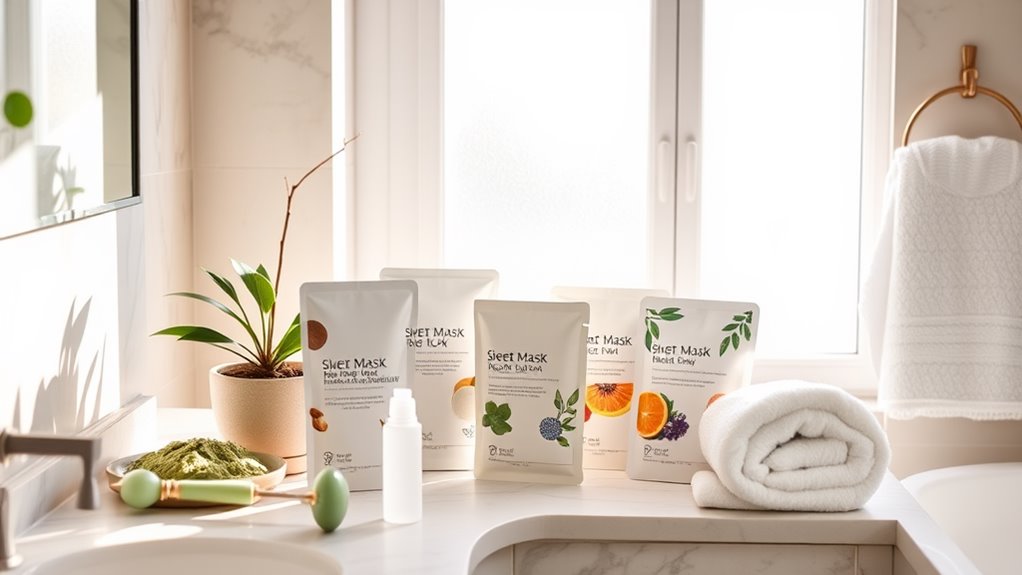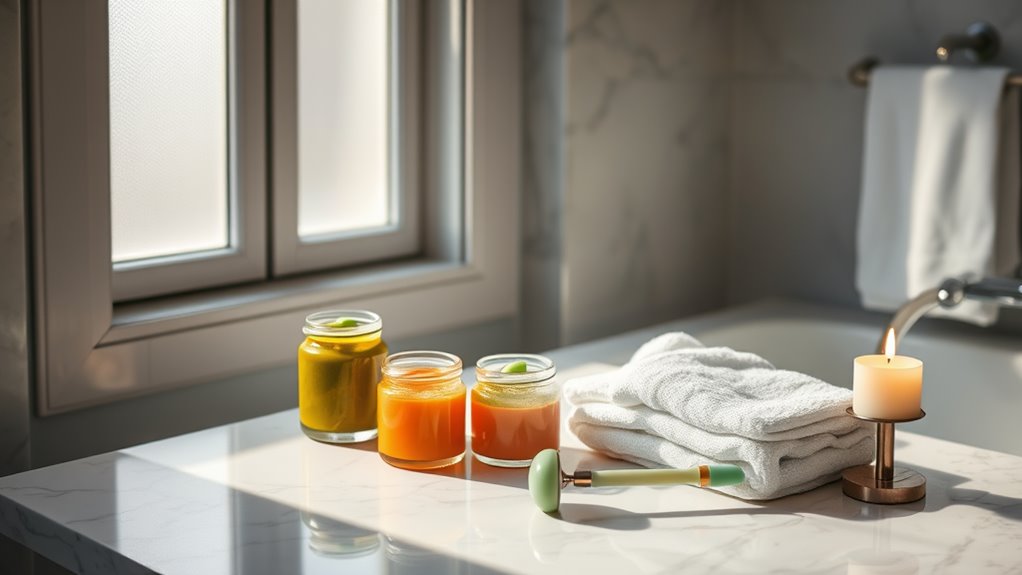Masking Routine That Works for Every Skin Type
To create a masking routine that works for every skin type, first identify your skin type: oily, dry, combination, or sensitive. Start with a clean face, then choose a mask suited to your skin’s needs—like clay for oily skin or aloe vera for sensitivity. Allow the mask to sit for the recommended time, and avoid using it too often. Each skin type benefits from tailored ingredients, so keep exploring to find the perfect routine for you.
Key Takeaways
- Begin with a thorough cleanse to ensure your skin is free from dirt and impurities before masking.
- Identify your skin type to select the most suitable mask ingredients for optimal results.
- Apply the mask evenly and allow it to sit for the recommended duration to maximize benefits.
- Avoid overusing masks to prevent irritation and maintain skin balance across all skin types.
- Consider incorporating natural ingredients tailored to your skin type for enhanced effectiveness and comfort.
Understanding Your Skin Type
Understanding your skin type is essential for selecting the right products and treatments. You’ve got to recognize whether your skin is oily, dry, combination, or sensitive to make informed choices.
Each type reacts differently to ingredients, so don’t overlook this vital step. For example, if you have oily skin, a universal mask that targets excess sebum can work wonders. On the other hand, dry skin might benefit from a hydrating mask packed with nourishing elements.
Assess your skin’s unique needs and concerns; this knowledge empowers you to tailor your masking routine effectively. By mastering your skin type, you’ll enhance your results and truly elevate your skincare game, ensuring you use the right universal mask for your specific needs. Additionally, understanding how different skin types react to ingredients can help you avoid products that may cause irritation or breakouts.
Essential Steps for an Effective Masking Routine
To achieve the best results from your masking routine, it’s crucial to follow a few essential steps.
First, always start with a clean canvas. Gently cleanse your skin to remove dirt and oil, allowing the mask to penetrate effectively.
Second, choose the right mask for your skin type. Whether you need hydration, exfoliation, or detoxification, selecting a suitable mask maximizes benefits. For instance, homemade face masks can be tailored to specific skin needs using common kitchen ingredients.
Lastly, allow the mask to sit for the recommended time. Resist the urge to leave it on longer; overuse can irritate your skin.
Recommended Natural Ingredients for Each Skin Type
Selecting the right mask isn’t just about the application; it also involves knowing which natural ingredients suit your skin type best.
For dry skin, look for ingredients like honey and avocado oil, which provide intense hydration and nourishment.
If you have sensitive skin, chamomile and aloe vera can soothe irritation and reduce redness.
For combination skin, try using rosewater and green tea to balance oil production while maintaining moisture.
Finally, if you’re dealing with acne-prone skin, consider masks with tea tree oil and witch hazel, as they help combat breakouts and inflammation. Additionally, using natural ingredients can enhance the effectiveness of your DIY face mask for achieving glowing skin.
Customizing Masks for Oily Skin
When you have oily skin, customizing your masks can make a significant difference in managing shine and preventing breakouts.
Focus on incorporating specific ingredients that target excess oil and minimize pores. Here are three essential components to take into account:
-
Clay: Bentonite or kaolin clay absorbs oil and impurities, leaving your skin fresh and clean.
-
Charcoal: Activated charcoal draws out toxins and prevents clogged pores, reducing the chance of acne.
-
Tea Tree Oil: This natural antiseptic fights bacteria and soothes inflammation, helping to control breakouts. Additionally, be mindful of hidden habits that may worsen your acne and adjust your skincare routine accordingly.
Tailoring Masks for Dry and Combination Skin
When it comes to dry and combination skin, choosing the right mask is essential for achieving hydration.
You’ll want to look for ingredients that lock in moisture and restore your skin’s balance.
Plus, applying your mask with the right technique can enhance its effectiveness and leave your skin feeling refreshed. For instance, a DIY kitchen face mask can be an excellent option, utilizing common ingredients that provide nourishment and hydration.
Best Ingredients for Hydration
Hydration is essential for maintaining healthy skin, especially if you have dry or combination skin. To achieve ideal moisture levels, focus on these key ingredients in your masks:
-
Hyaluronic Acid: This powerhouse ingredient attracts and retains water, providing intense hydration without making your skin greasy.
-
Glycerin: A humectant that draws moisture from the environment, glycerin helps keep your skin plump and supple.
-
Aloe Vera: Known for its soothing properties, aloe vera not only hydrates but also calms irritation, making it perfect for combination skin.
Incorporating these ingredients into your masking routine can transform your skin’s hydration levels, ensuring you maintain a balanced, radiant complexion.
Recommended Application Techniques
Finding the right application techniques is crucial for maximizing the benefits of your masks, especially for dry and combination skin.
Start with clean, slightly damp skin to enhance absorption. Use a gentle touch, applying the mask with your fingertips or a brush, focusing on dry areas like cheeks and avoiding overly oily zones.
Apply a thicker layer where your skin feels tight, allowing it to hydrate deeply. For combination skin, consider a multi-masking approach: use a hydrating mask on dry areas and a balancing one on oilier zones.
Always follow the manufacturer’s recommended time for maximum efficacy.
Finally, rinse with lukewarm water, and seal in moisture with a nourishing moisturizer—this guarantees your skin reaps all the benefits.
Soothing Masks for Sensitive Skin
If your skin tends to react to various products, soothing masks can be a game-changer in your skincare routine.
These masks not only calm irritation but also hydrate your sensitive skin. To maximize their benefits, focus on these key ingredients:
-
Aloe Vera: This natural hydrator soothes and reduces redness while providing essential moisture.
-
Chamomile Extract: Known for its anti-inflammatory properties, chamomile helps calm irritation and promotes healing.
-
Oatmeal: Colloidal oatmeal acts as a barrier, protecting your skin and alleviating dryness.
Incorporate these soothing masks into your regimen, and you’ll notice a significant reduction in sensitivity.
Remember to patch-test any new product to verify compatibility with your unique skin.
Master these techniques, and enjoy a calmer complexion!
Frequently Asked Questions
How Often Should I Mask My Skin Each Week?
You should mask your skin two to three times a week, depending on your skin’s needs. Listen to your skin; adjust frequency based on how it responds to treatments for best results.
Can I Use Multiple Masks in One Session?
Yes, you can use multiple masks in one session. Just guarantee you tailor each mask to your skin’s specific needs. Apply them strategically, starting with the one that requires the longest time to work effectively.
What Should I Do if a Mask Irritates My Skin?
If a mask irritates your skin, remove it immediately and rinse with cool water. Apply a soothing moisturizer or aloe vera to calm your skin, and avoid using that mask again in the future.
Are There Any Masks Suitable for Acne-Prone Skin?
Absolutely, you should look for masks containing salicylic acid, clay, or tea tree oil. These ingredients help reduce inflammation, unclog pores, and control excess oil, making them ideal for managing acne-prone skin effectively.
How Do I Properly Remove a Face Mask?
To properly remove a face mask, gently peel or rinse it off with lukewarm water. Use a soft cloth or your fingertips, ensuring you’re thorough to avoid residue. Follow up with your regular skincare routine for best results.





